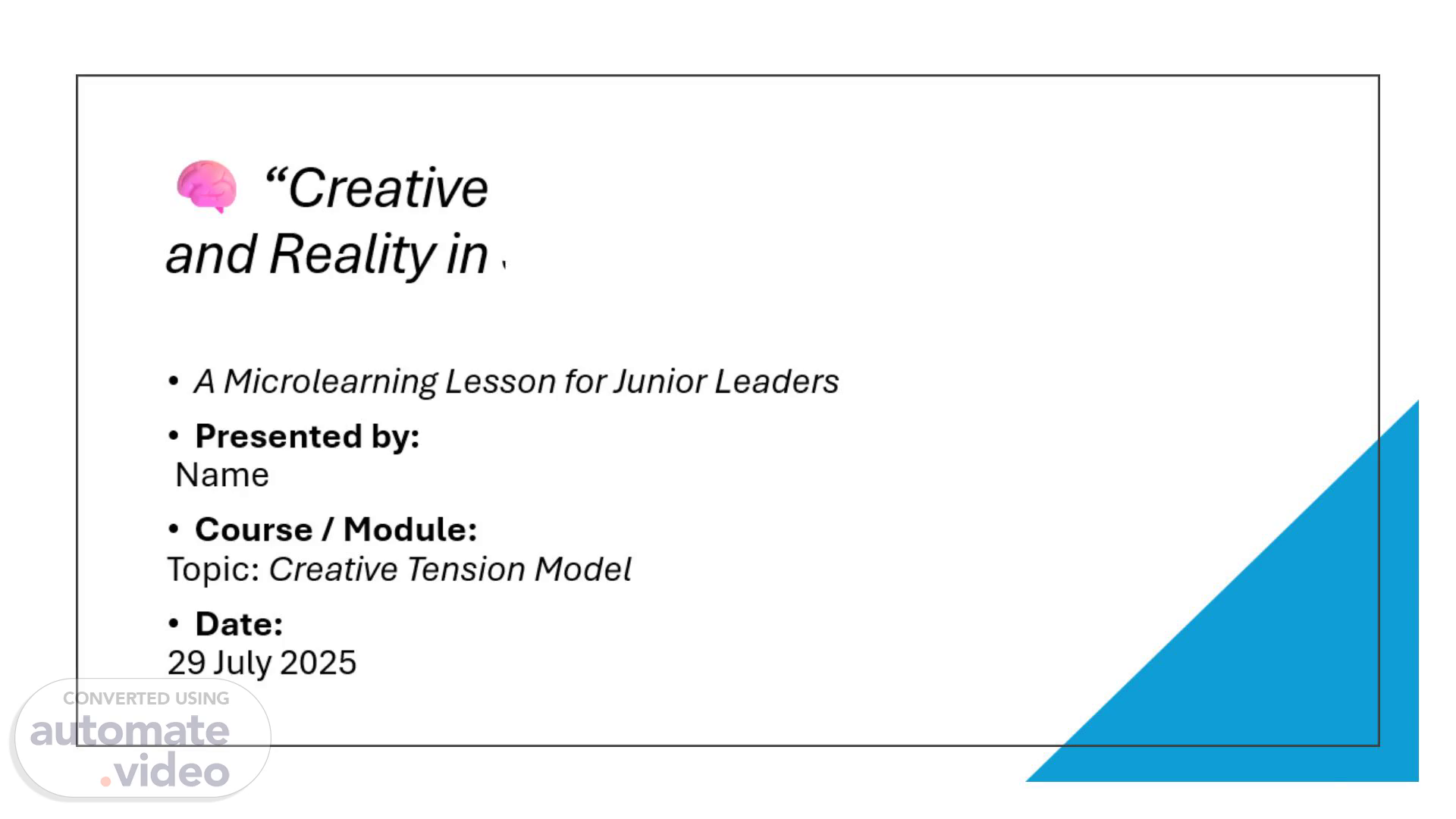
🧠 "Creative Tension: Bridging Vision and Reality in SAF Leadership"
Scene 1 (0s)
🧠 “Creative Tension: Bridging Vision and Reality in SAF Leadership”.
Scene 2 (13s)
[image]. 🔍 Understanding Creative Tension in SAF Leadership.
Scene 3 (45s)
Learning Objectives. 🎯 By the end of this lesson, SAF junior leaders will be able to: Define the concept of Creative Tension and distinguish it from Emotional Tension. Understand how creative tension supports personal and professional growth in high-performance environments like the SAF. Apply the concept using tools like the Ladder of Inference in daily leadership interactions. Reflect on their own leadership journey and identify current gaps between vision and reality. Engage in peer learning through scenario-based examples and interactive quizzes..
Scene 4 (1m 10s)
[image]. What is Creative Tension?. Definition: Creative Tension is the energy created when a person holds a clear vision of what they want and simultaneously acknowledges their current reality, without denial or blame. “Creative tension is not stress. It’s the natural tension that arises from the gap between vision and current reality.” — Peter Senge, The Fifth Discipline 🔁 Key Elements: Vision: The desired future (e.g., becoming an inspiring, open leader) Current Reality: Where you are now (e.g., struggling with communication or self-doubt) The Gap: Source of energy for learning and growth—not frustration 💡 SAF Example: A junior leader aspires to lead with empathy, but currently reacts defensively under pressure. Recognizing the gap helps them stay focused on improvement..
Scene 5 (1m 44s)
Creative Tension vs Emotional Tension. ✅ Creative Tension Comes from the gap between vision and reality Focuses on growth and learning Encourages reflection and action Seen as a challenge to overcome Example: “I don’t know this yet—but I’ll learn.”.
Scene 6 (2m 7s)
Case Study – Person A (Creative Tension). 🧍♂️ Meet Person A: A Junior Leader in SAF 🎯 Vision: “I want to become the kind of leader who fosters open communication and team learning.” 📍 Current Reality: “I often jump to conclusions and find it hard to hold open conversations when I’m under stress.” 🧠 How Person A Responds (Creative Tension Approach): Accepts the gap honestly, without judgment. Starts using the Ladder of Inference in conversations with peers. Actively seeks feedback from course facilitators. Views the challenge as a learning opportunity, not a weakness. ✅ Outcome: Builds confidence steadily through real conversations. Shares progress during reflection sessions. Inspires others by modeling openness and growth..
Scene 7 (2m 39s)
Case Study – Person B (Emotional Tension). 🧍♂️ Meet Person B: Same Role, Different Response 🎯 Vision: “I want to be seen as a competent and knowledgeable leader who’s on top of all the tools.” 📍 Current Reality: “I don’t fully understand these concepts and struggle to apply them in practice.” 😟 How Person B Responds (Emotional Tension Approach): Feels anxious and embarrassed about not understanding. Avoids group discussions and copies others’ reflections. Focuses on looking good instead of learning deeply. Begins to resent the course and doubt its usefulness. ❌ Outcome: Gains very little from the course. Confidence drops over time. Misses the opportunity to grow as a leader..
Scene 8 (3m 9s)
Relevance to SAF. Why the Creative Tension Model Matters in SAF 🔗 Realities of Leadership in SAF: Junior leaders are often thrust into high-responsibility roles early. There's constant pressure to perform, adapt, and lead by example. Leadership is not just about knowing—it’s about growing. 💡 How Creative Tension Helps SAF Leaders: Encourages self-awareness without self-criticism. Strengthens resilience by embracing challenges as growth opportunities. Promotes continuous learning through honest reflection. Reduces emotional burnout by shifting focus from image to improvement. 🎓 Example: A platoon sergeant uses creative tension to stay focused on their vision of being a calm, supportive mentor—even when under operational stress..
Scene 9 (3m 40s)
Bright ladder against dull ladders. Applying the Model – The Ladder of Inference.
Scene 10 (4m 10s)
Applying the Model – The Ladder of Inference. 🪜 What is the Ladder of Inference? The Ladder of Inference is a tool that helps leaders become aware of how they form judgments and how to slow down reactive thinking..
Scene 11 (4m 24s)
🔄 How It Works: Each rung represents a mental step we take when interpreting situations: Observe data and experiences Select specific data Add meaning based on culture or past experiences Make assumptions Draw conclusions Adopt beliefs Take actions based on those beliefs.
Scene 12 (4m 41s)
Interactive Quiz – Check Your Understanding. Wood human figure.
Scene 13 (5m 3s)
Summary – Key Takeaways. 📌 What We’ve Covered Creative Tension is the energy between where you are and where you want to be. It’s productive, helps leaders stay motivated, and drives real growth. Emotional Tension, in contrast, creates anxiety and defensiveness. Using tools like the Ladder of Inference can help SAF leaders respond more consciously. The journey from reality to vision is not weakness—it’s the path to leadership excellence..
Scene 14 (5m 26s)
References. 📚 Citations Senge, P. M. (2006). The Fifth Discipline: The Art & Practice of the Learning Organization (Revised ed.). Doubleday. Harvard Business Review. (2014). The Ladder of Inference. Retrieved from https://hbr.org/ Singapore Armed Forces. (n.d.). SAF Core Values. Retrieved from https://www.mindef.gov.sg/ ChatGPT. (2025, July). Content support for microlearning lesson. OpenAI. DALL·E. (2025). Visual aids and diagrams for instructional content. OpenAI. Canva. (2025). Presentation design and layout tools. Retrieved from https://www.canva.com/.